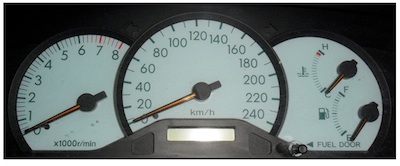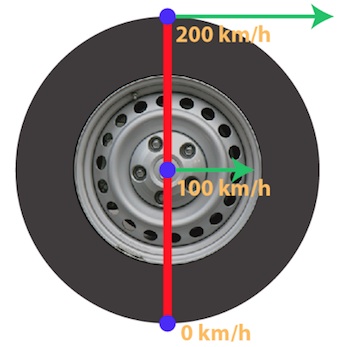How fast is your car?
by Burkard Polster and Marty Ross
The Age, 28 March 2011

Above is the dashboard of the QEDcat Cruiser. What kind of car might it be? No, it’s not a Jaguar - much as we wish, and as the 240 km/h maximum on the speedometer might suggest.
In fact the Cruiser is much more a housecat of a car, a sleepy Toyota station wagon. And be reassured, your Maths Masters have never had any hotrod confrontations with the police. Well, there was that one charge of attempted speeding …
In fact, our Cruiser begins to disintegrate if it approaches any speed remotely close to 120 km/h, halfway up the dial. So, what was Toyota thinking when it included that speedometer range? We’re not sure we have a good answer, but let’s first consider how a speedometer works.
The speed in a car is measured indirectly. The car can measure the number of revolutions of the wheels per second. Then, multiplying by the circumference of the car’s tyres gives the speed. Easy!
However, things can also easily go wrong. If the revolution rate is measured inaccurately then so also is the speed. Similarly, the speedometer must be calibrated to the car’s tyres. If the tyres are underinflated, then the speedometer will overestimate your speed. Conversely, installing big tractor tyres will result in your traveling faster than indicated by the speedometer.
Notably, speedometers in cars made before 1988 do not have to pass any test for accuracy. And, speedometers of cars manufactured between 1988 and 2007 need only be accurate to within 10% of the actual speed. So, in such a car actually traveling at 100 km/h, the speedometer is only required to indicate a speed between 90 km/h and 110 km/h.
Given this, what was the Victorian Government’s thinking behind the current 3 km/h tolerance for speeding? After all, a perfectly legal speedometer of an older car may well be showing that the car is driving at 100km/h, while actually traveling 7 km/h above the permitted tolerance.
The authorities assure us that it has nothing to do with revenue-raising. Of course. There’s no reason why they’re not totally trustworthy on this score. No reason at all.
Presumably, the 3km/h tolerance is supposed to be a safe upper estimate of the inaccuracy of speed-detecting radar guns. However, after reading a recent article by John Barrow, we wonder whether this can be true.
A radar gun measures the speed of a spot on your car with respect to the ground. (The way it does this is very clever, but we’ll leave that discussion for another day.) The problem is, different spots of your car travel at different speeds.
Suppose the body of your car is travelling at 100 km/h. Then as well the axles and the centres of the wheels are traveling at 100 km/h. However, the bottom point of a tyre is touching the road, and at that instant is not moving.

What about the top point of the wheel. Think of the three blue points being connected by the red line. The bottom point is pinned to the ground (for that moment), and so pushing the middle point to have speed 100 km/h means the top point will move twice as fast, at 200 km/h.
Is this an issue for the radar guns? Probably not when targeting cars, since the tops of the wheels are not directly visible. However, for motorbikes it may well be a different story.
Still it’s probably unlikely. However, our argument does suggest a use for Toyota’s silly dial: you can install a second hand to indicate the maximum speed of the bits of your car. How have we ever lived without it?

Puzzle to ponder: The QEDcat cruiser is out of action, and so you’re riding your bicycle. At the moment a bike pedal is at the bottom of its rotation, is the pedal moving forward or backward relative to the ground?
Burkard Polster teaches mathematics at Monash and is the university's resident mathemagician, mathematical juggler, origami expert, bubble-master, shoelace charmer, and Count von Count impersonator.
Marty Ross is a mathematical nomad. His hobby is smashing calculators with a hammer.
www.qedcat.com
Copyright 2004-∞ ![]() All rights reserved.
All rights reserved.